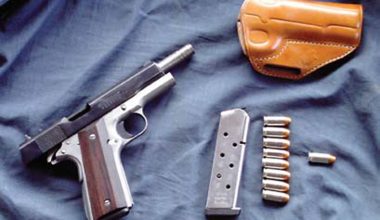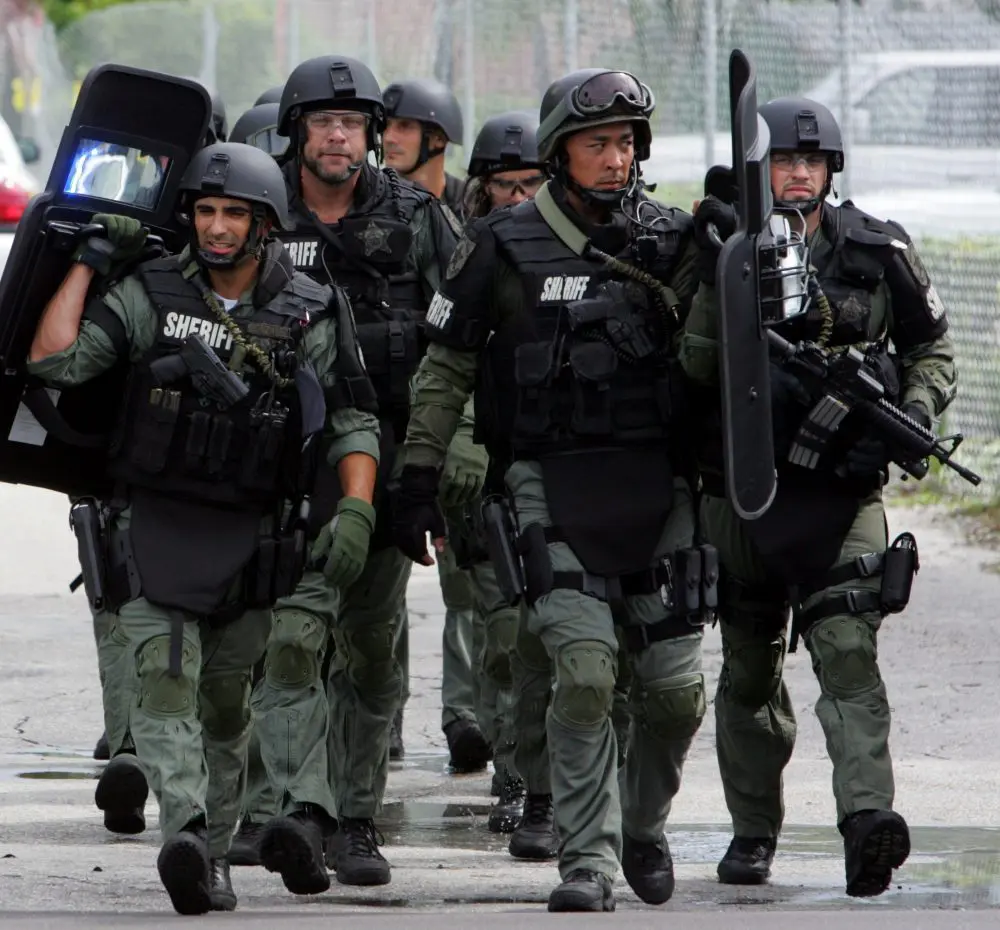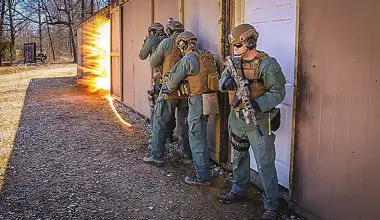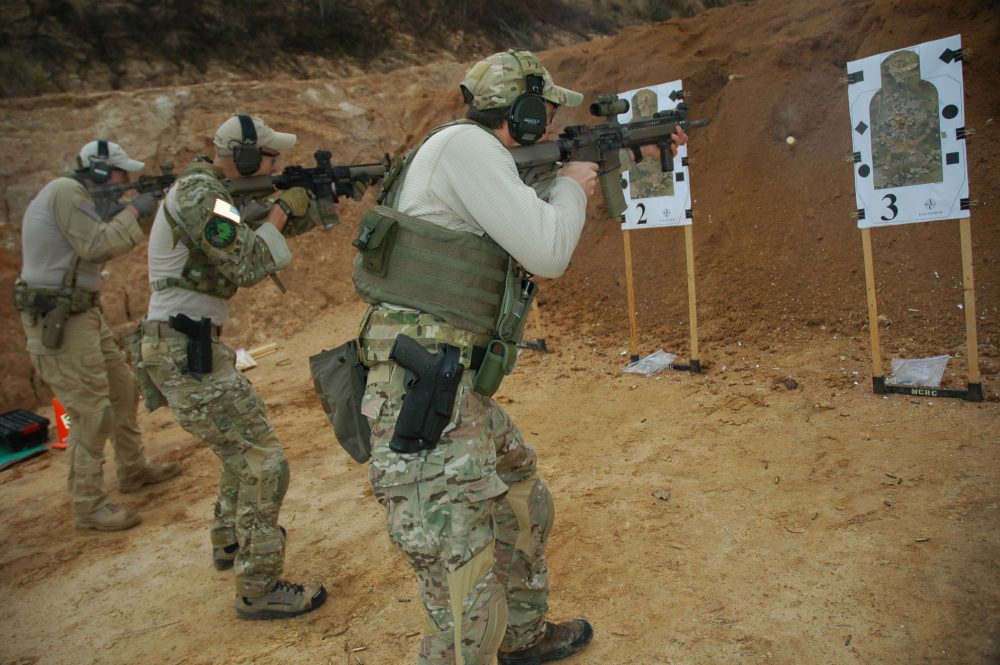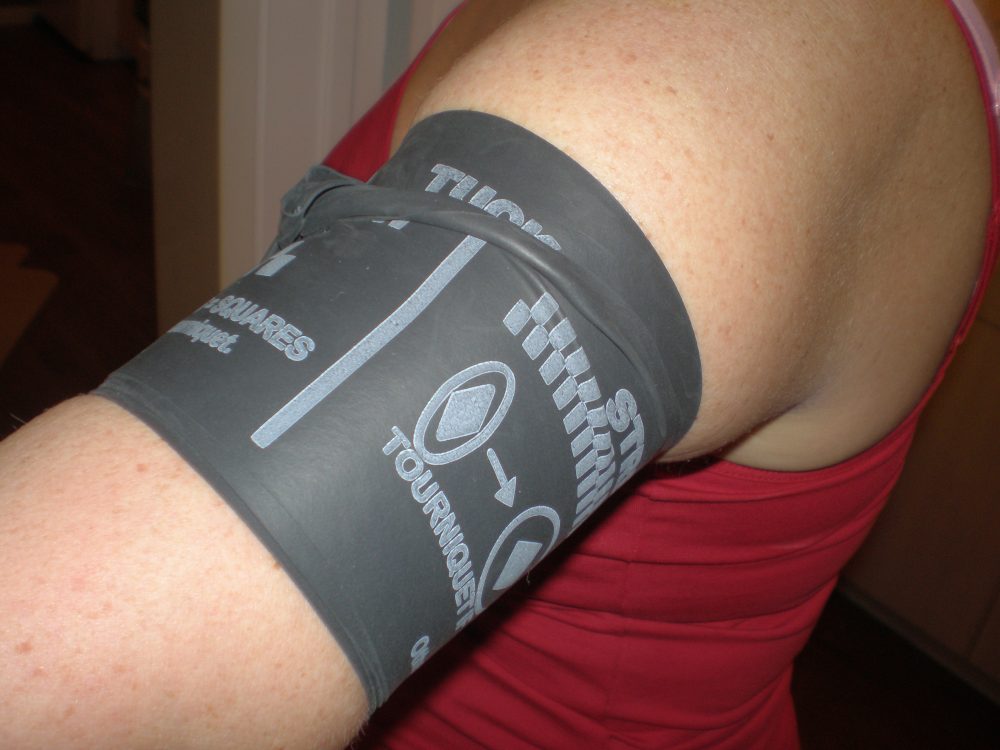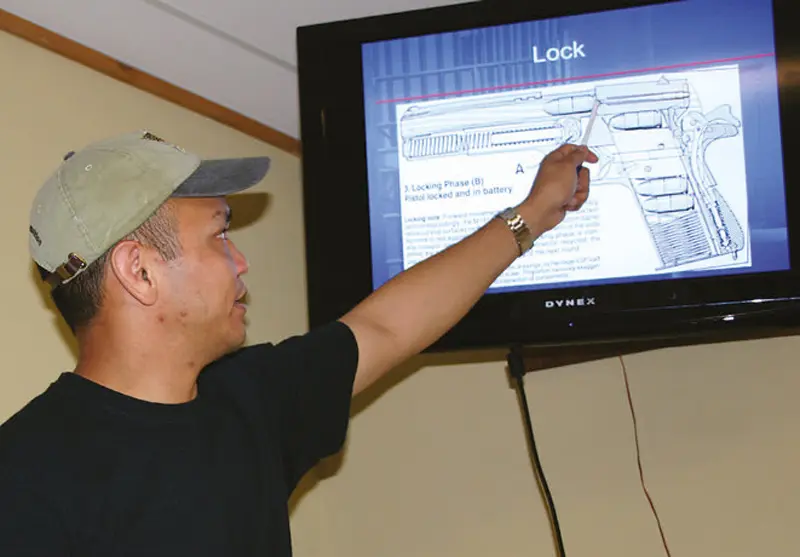
NO matter which new handgun design hits the market, people still flock to one with a century-old pedigree: the 1911. It’s become an American icon. Some may consider it antiquated, but others beg to differ. And while some owners see their 1911 as just a part of their collection, others consider it a first-line firearm that they stake their life on.
If one intends to have their life depend on a 1911, they need a higher level of knowledge about this handgun. Whether the owner is an LEO who will be carrying a 1911 on duty, or an enthusiast seeking more detailed knowledge about the platform, one training organization stands out in providing that skill: 10-8 Consulting.
Heading up the 10-8 Consulting team is Tim Lau, a southern California-based LEO and department armorer and trainer. For the 10-8 Consulting 1911 Diagnostics & Operation Course that I attended, he was joined by Erick Gelhaus, another California-based LEO armorer and trainer whose articles have appeared in this magazine, and Joe Reidy, a recently retired LEO who keeps busy training officers and supporting several firearms platforms, including the 1911.
Completing the dream team, Hilton Yam, an LEO and legend in the 1911 gunsmithing world (so much so that he is not currently accepting work), was on hand to provide his gunsmithing expertise. Hilton also produces a line of products for 1911s and other firearms, most notably sights (10-8 PERFORMANCE REAR SIGHT: A Different Way To Look At Things, July 2006 S.W.A.T.) under the banner of 10-8 Performance.
The level of knowledge, skill, and training ability of the 10-8 crew is exemplary. Any of the instructors would be worth training with on his own. All carry or have carried a 1911 on duty and have served as armorers and training officers for their respective departments. Being armorers, they emphasized that there is no such thing as a drop-in part with a 1911. Virtually everything requires skilled hand fitting by someone experienced in working on the platform.
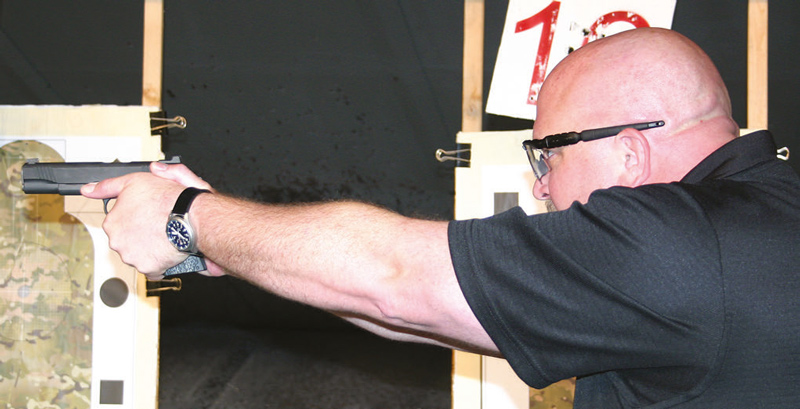
While being able to fit the parts was far beyond the scope of the class, it’s important to be able to recognize sources of problems and select the most appropriate parts. The instructors reviewed what they found to be the best among parts, magazines, accessories, and modifications.
Not every gunsmith or armorer who claims to be able to work on a 1911 is competent to do so. It requires a gunsmith or armorer with the level of knowledge and skill of one of the coinstructors.
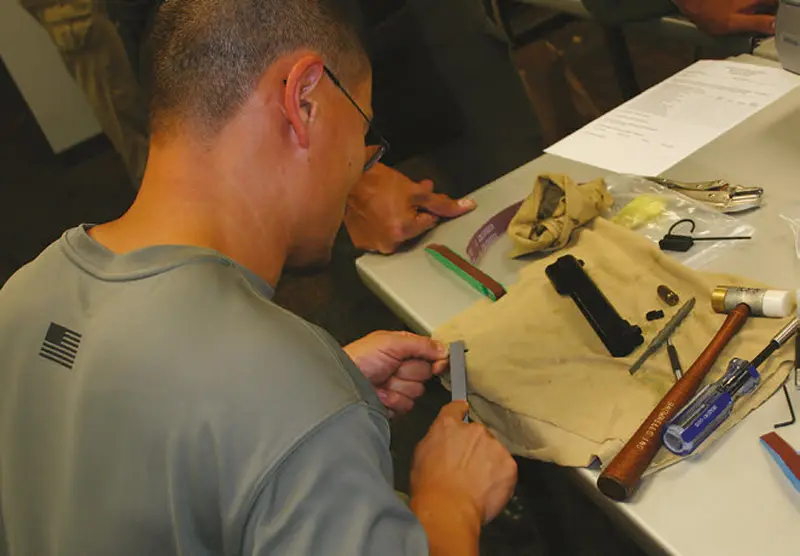
Table of Contents
HISTORY LESSON
We began the class with a review of the 100-year history of the 1911. The 1911 was designed at a time when labor was cheap and machinery was expensive. Not only were there more people skilled in hand fitting parts if necessary, but all the parts were built to a single uniform specification. This was the case up through World War II, when 1911s were built to fulfill government contracts.
Nowadays we have countless companies making 1911s and parts, but few—if any—adhere to a standard. In addition, many modern manufacturing methods result in guns and parts being built faster and more economically but with less quality control and hand fitting. Thus, many 1911s need skilled gunsmithing to reach the level that one could safely rely on it as a duty or defensive weapon.
Further, when it comes time to change or repair a part, we are no longer dealing with a gun or parts built to a single standard, so fitting these parts requires a higher level of skill and experience.
The 10-8 instructors believe the 1911 works best as it was originally designed: as a five-inch barreled Governmentsized steel-framed handgun in .45 ACP using select single-stack seven- or eightround magazines. Any deviation from this formula will result in a smaller window of reliable operation.
Tim Lau guided the class through a comprehensive PowerPoint review of the 1911, including its history, what proper parts should look like, and how they should fit together and interact. He contrasted them with photos of incorrectly set up guns and parts. He also passed around examples of what he was talking about, demonstrating correct fit as well as highlighting other issues.
The instructors surveyed the market of current 1911s and went over the pros and cons of many manufacturers and models, a subject that would require a multipart article to cover. They recommended several makes and models for serious use. Topping that list was the Springfield Armory Professional, followed by the Springfield MC Operator and TRP models, the Colt Railed 1911, and the Smith & Wesson E-Series 1911s (though no earlier S&Ws than the E Series).
Once selected, the 1911 would need to be inspected by a competent 1911 smith or armorer. Depending on the level and quality of the gun, the pistol might need some additional work before it would be suitable for duty use.
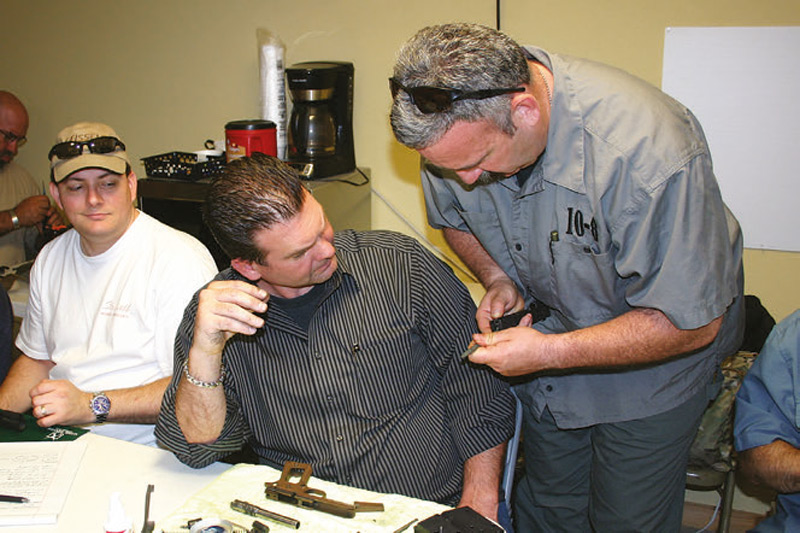
HANDS ON
The guns that the students brought to class represented a panoply of modern 1911s, ranging from standard-grade models to high-dollar brands selling for several thousand dollars. This included guns with that amount invested in gunsmithing from some of the top names in the business.
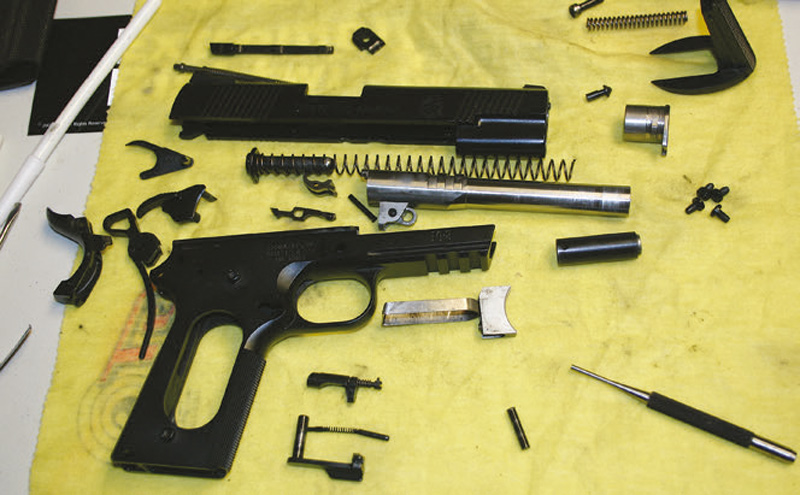
Next, the instructors went over the correct way to field strip a 1911, even though everyone in the class knew how to take their gun apart. After the students had field stripped and reassembled their handguns several times, it was time to conquer detail stripping the guns down to their most basic subcomponents. At every step, Tim Lau made sure the entire class was with him before he proceeded. During this activity, the other 10-8 instructors circulated among the students, answering questions and rendering assistance when necessary.
Once the guns were fully disassembled, the instructors walked us through inspecting each individual part, with their own parts and PowerPoint slides illustrating what the parts should look like. Some small parts were replaced outright by digging into the 10-8 stash of products.
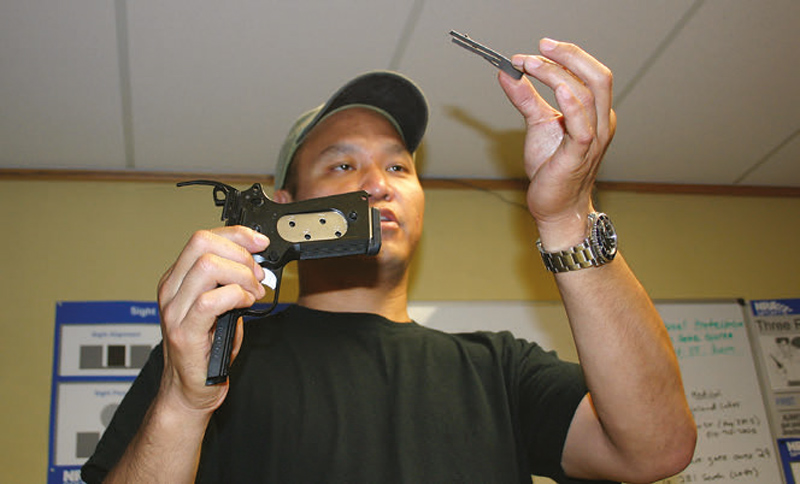
EXTRACTOR WORK
Hilton Yam found himself doing quite a bit of filing on extractors, as well as a bit of other minor work. He used the file to correct the extractor’s geometry— something he is an expert at from years of experience. Seeing Hilton painstakingly file an extractor at an exacting series of angles was like watching an oldtime artisan at work. Extractor tension is a tightrope of tolerances: while more tension aids in reliable extraction, too much can interfere with feeding, which may then be mistakenly attributed to a problem with the barrel or feed ramp.
A fair amount of time was spent discussing the 1911’s extractor, as this part is crucial to the reliable function of the 1911, because it affects several steps of the firearm’s cycle of operation. Since ill-fitting extractors are a major contributor to 1911 maladies, the instructors passed around several slides with extractors that were too loose or too tight, along with dummy rounds to allow us to observe this relationship.
To work correctly, the extractor needs to be fit by someone who has the knowledge and skill to adjust the tension to the correct level, and be able to use a file to achieve the correct bevel and geometry to maximize reliability. The extractor may need replacement or adjustment after 5,000 rounds. However, it is important to keep in mind that the original 1911’s acceptance test and life expectancy were 6,000 rounds in a day when people fired far fewer rounds in practice. The instructors also explored the history of external extractors and explained why many had failed.
We then reassembled our slides and worked with dummy rounds to verify the extractor tension. Hilton also set up some sample slides with too much extractor tension and too little, then passed them around to allow us to feel the difference. He also took advantage of students’ problem guns to provide on-the-spot teaching examples.
We completed detailed reassembly of our guns, including many tips and tricks to make the process smoother. The instructors believe that every 1911 user needs to be able to fully detail strip their gun, because eventually they will need to perform a detailed cleaning. Also, if the gun winds up getting soaked, it may very well be necessary to fully disassemble the gun simply to dry off and lubricate parts that would otherwise rust.
Once reassembled, the instructors guided us through a comprehensive safety check to insure that all of our guns’ safeties were operational, along with a general function check of the guns. We then discussed recoil springs and proper lubrication.
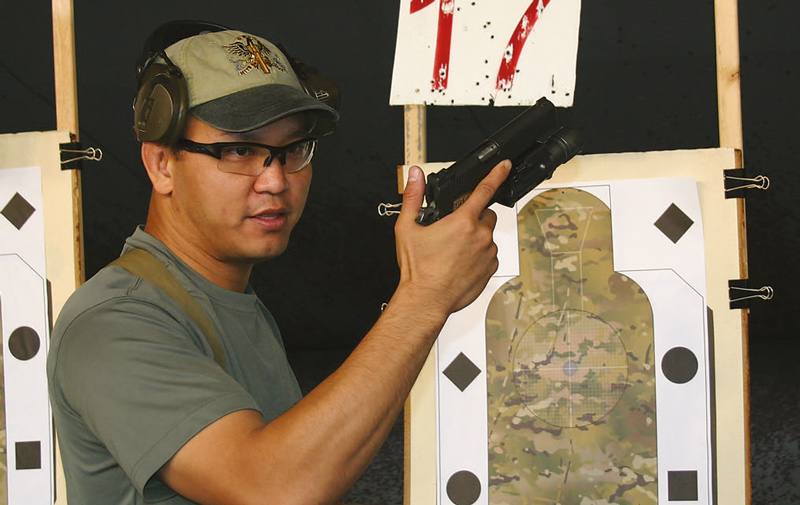
TRAINING DAY TWO
The second day of class was spent at the firing range. Tim Lau began the session at square one, covering proper hold and manipulations for loading and unloading the gun.
Joe Reidy took over and led the class through the fundamentals of shooting the 1911—everything from grip to stance. He placed heavy emphasis on trigger control, with the goal being to apply only enough pressure to break the shot. Joe pointed out that problems with jerking or incorrectly operating the trigger account for more accuracy issues than any other factor. The short, smooth trigger that slides straight back with minimal pre-travel is a hallmark of the 1911, so Joe wanted to insure that we operate it to its fullest potential. Ideally, we should be allowing the trigger to reset for the next shot during recoil.
Next Joe stressed follow-through— trying to pick up the sight picture as the shot breaks as opposed to lowering the gun after each shot to try to see where you hit—a very bad habit that can lead to shooting low as you start lowering the gun when you are pulling the trigger.
Once we’d fired some drills, drawstrokes were added and covered in detail, especially as they apply to disengaging the safety of the 1911. The 10-8 instructors present favor the modified Isosceles stance and stressed that you want to bring the gun up as high as possible after drawing from the holster before bringing your arms together, and then coasting your arms out, but stopping before they are fully extended. The sights should be picked up as soon as possible while the gun is being extended.
We practiced the drawstroke dry with 10-8 instructors circulating, then went live fire and later added malfunction clearances.
FUNCTION TEST
Once we’d spent some time practicing and running drills, the instructors introduced a 50-round function test using hollow points or duty ammo. Since the 1911 was originally designed to work with 230-grain FMJ ammo, many will not work with hollow points without skilled gunsmithing and the right magazines, and some will not run reliably with certain brands of hollow points.
The magazines work together with the 1911 to form a weapon system. Just because a magazine may function perfectly with one 1911 with certain ammo doesn’t mean it will do so with a different sample. A number of factors come into play, creating a tolerance stacking among the weapon, the magazine and the ammo. Thus, it is vitally important to test whatever defensive ammo you plan to use with the gun along with all your intended magazines to insure reliable functioning.
In addition to the 50-round function test, the instructors urge users to fire at the very least 200 rounds of the defensive ammo they plan to use in the gun to insure reliability.
The test’s firing protocol included shooting the gun strong hand only, weak hand only, deliberately limp wristing it, firing rounds without a magazine in the gun to make sure the rounds properly eject, and firing the gun as fast as you can pull the trigger.
If the gun malfunctioned at any point during the drill, it failed. The shooter then left the line and had Hilton Yam give the gun some personalized correction. Once repaired, the student refired the drill. Approximately 30% of the guns did not make it through this test without malfunctioning. The number would undoubtedly have been higher had Hilton not worked on some of the guns the day before.
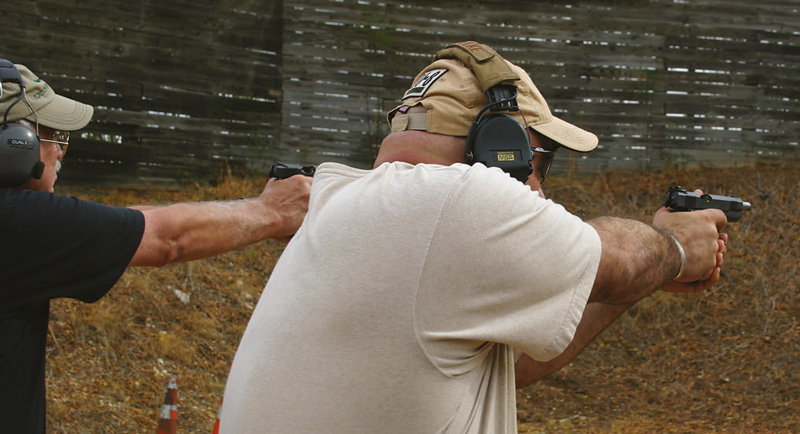
FIRSTHAND EXPERIENCE
My Springfield 10-8 Operator performed flawlessly in the class using standard velocity Federal HST hollow points for the function test and a mix of HST, Black Hills FMJ, and Ranger Talon JHPs for the rest of the class. However, when I was shooting the same gun a few days before the class, it erratically failed to feed the HST ammo. During the class, nothing stood out with the gun during disassembly and inspection, so no changes were made to it.
I decided to try some of the HST in class using the mags it had choked with. This would give the 10-8 pros something concrete to analyze if any problems surfaced with my gun. To my surprise, the gun functioned flawlessly with the previously problematic load. After firing a box of the ammo with no issues, I decided to save the rest for the function test, which the gun passed without a single bobble.
This sudden correction was puzzling, because no changes had been made to the gun to explain the improvement in reliability with this ammo. Wondering when issues with that particular load might pop up again, I decided to restrict any defensive ammo to loads that had exhibited a more reliable and consistent track record in my gun.
The 10-8 crew recommend running this test every six months if you are staking your life on your 1911. They stressed that if you carry a 1911, there are specific requirements for end-user knowledge and maintenance that cannot be ignored. Seeing issues with my 1911 and other students’ guns reinforced the instructors’ view that if it’s your primary gun, the 1911 isn’t for everyone, and often cannot be relied upon straight from the factory.
Sadly, if you follow current firearms on the market, it’s clear that this issue is not confined to 1911s and has expanded to encompass many formerly reliable brands and models.
Speaking as someone whose life does depend on his 1911 functioning reliably, I recommend this course unreservedly. The skills and expertise the entire 10-8 crew possess simply can’t be beat.
